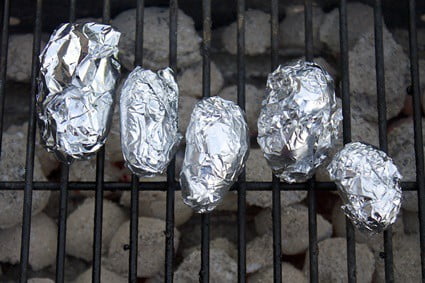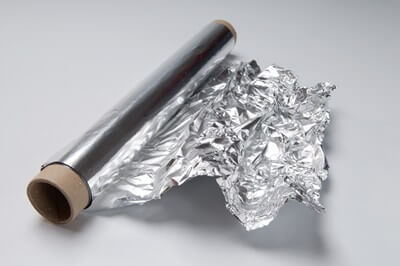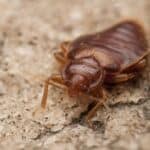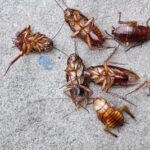Cockroaches are insidious creatures known for getting into anything. If food or trash is lying around, they will find it. That’s probably why you wrap up leftover food or ingredients in aluminum foil. We like to think that this prevents roaches from gaining access, lets the food breathe a little, and allows you to keep it on kitchen counters. Unfortunately, that’s not always the case.
Roaches can chew through aluminum foil. Their strong mandibles mean that they can rip the thin metal easily. Tinfoil may be thicker, but it will still tear. You can’t trust the reflective nature of foil to scare off roaches, either. While roaches aren’t looking to eat aluminum foil, they can bite through it to access food.
Never place food out in the open where roaches can get it. Even a tightly wrapped bundle of foil isn’t air-tight. This can let food scents drift out and attract roaches. Instead, put food in glass, thick plastic, or thick metal. If you prefer aluminum foil, then be sure to wrap your food multiple times.
Can Cockroaches Chew Through Foil?
Cockroaches can bite through foil because aluminum is a thin, flimsy metal.
When it’s used as a foil, this is intentional so that we can easily mold it around our food to preserve it. You can easily tear this foil by hand or by accident, should you brush it against another object.
Cockroaches do not have teeth, but their mandibles are sharp and strong. This allows them to chew through soft plastics, like bread bags. The foil around your food is no more resilient. It won’t take more than a few minutes for a roach to bite through the foil.
Can Aluminum Foil Attract Cockroaches?
Cockroaches are not drawn to aluminum foil. The material itself plays no factor in whether or not the roach will pursue your food. However, cockroaches are drawn by scent. Aluminum foil, even when tightly wrapped around your food, does not always create an airtight seal. This will allow odors from your leftovers to drift out into the open air.
Cockroaches have an impressive sense of smell and will detect these alluring aromas. This may draw them to your counters, tables, or your refrigerator. Once there, they can then eat through the foil and gain access to your food. That’s not only gross but dangerous. According to the peer-reviewed journal Pest Control, roaches can spread enough bacteria and disease to be a serious health hazard.
Do Cockroaches Like Aluminum Foil?
Cockroaches do not like or dislike the flavor of aluminum foil. They won’t eat it if they have other food available. Likewise, they won’t avoid it if chewing through the thin metal means they’ll gain access to real food.
That’s because aluminum foil is composed of metal. Roaches eat organic matter of every kind, from hair to skin flakes to paint. However, metal like aluminum is not considered organic. Cockroaches can’t gain any nutrients from eating it.
That doesn’t mean it drives roaches away. Cockroaches may eat aluminum foil as they work their way to real food. They may also tear it to create an opening. Once they’ve accomplished that, they’re likely to ignore the foil.
Does Aluminum Foil Scare Cockroaches?
There is a myth that cockroaches are afraid of aluminum foil. Supposedly, that’s because:
- It catches the light, shining on the roach or creating a mild flash, scaring the roach.
- Cockroaches can see their reflection, which startles roaches.
This leads some to believe that aluminum foil can be used as a roach deterrent. You can supposedly place it in key areas around your home to frighten roaches. It’s also allegedly the best thing to wrap food in to scare away roaches. This is a myth. Cockroaches are not scared of aluminum foil and won’t be deterred by its presence.
It’s unknown if cockroaches can recognize their own reflection. If they could, roaches are used to living in densely-populated colonies and are not scared by the presence of other roaches. Likewise, cockroaches are more likely to be scared by a kitchen light flicking on, not how foil reflects it.

Can Cockroaches Eat Through Tin Foil?
You may think that tin foil and aluminum foil are interchangeable. However, as the name implies, these two foils are made of different materials. For household uses, many people originally used tin foil to wrap their food. However, since it left a metallic taste on food, it was later swapped by leading brands for aluminum. This leaves no flavor behind.
Does Tin Foil’s Taste Deter Roaches?
If you want to be clever about a roach’s tastes, you may think tin is an easy fix. Roaches only eat organic matter, so the tinny flavor should drive them away, right?
Unfortunately, roaches are mainly driven by their sense of smell. Tin foil doesn’t give off a strong metallic smell. That means it can’t fool roaches into thinking there’s nothing other than metal present, with no food to be found.
Tin foil may leave a slight metallic taste on your food. However, by the time cockroaches realize this, it will be too late. They’ll have already taken a bite and contaminated your food. Once they have, they may leave fecal matter on your food. According to the Journal of Medical Entomology, that can be damaging to your health.
The cockroaches will probably ignore the flavor difference in exchange for good, organic matter with nutrients (the food itself). If a roach has touched your food, throw it away.
Is Tin Foil Too Thick For Roaches?
Tin foil is also slightly thicker than aluminum foil. This gives it a stiffer texture that’s less likely to rip or break as you wrap it around food. As such, you may think tin foil is too thick for roaches to chew through. Sadly, that’s not the case. Tin foil is still a thin metal. It can tear by hand and under the steady work of a roach’s mandibles.
Will Aluminum Foil Kill A Cockroach If They Eat It?
Technically speaking, a roach could die from eating too much aluminum foil. However, that’s just a hypothetical. It’s unlikely that the roach would consume enough aluminum foil to be harmed.
Aluminum, as a metal, is not an organic material. It has no nutritional benefits for a cockroach and won’t be properly digested. As such, a cockroach is unlikely to eat it in the way that roaches won’t eat your forks.
Most likely, a cockroach will nibble on a small amount of foil to reach your food. Once it gains access, it’ll ignore it for real food. This small amount of foil will not harm it whatsoever.
Even if a roach were starving, it wouldn’t resort to non-organic food. Instead, in its desperation, it would eat your kitchen towels, cardboard, or emulsion paint on your walls, which contain fat and are more organic.
How To Keep Roaches Away From Foil
Since foil won’t keep your food safe, you’ll need to protect it from roaches as well. You don’t need to write off aluminum or tin foil altogether. Instead, you can:
Store It Carefully
Don’t place food wrapped in foil on counters, tables, or anywhere a roach can access. Instead, place your food in a refrigerator.
Wrap It Tightly
Foil may allow food smells to drift out to roaches. Be sure to wrap the foil more tightly to prevent gaps. As a bonus, this will keep it more airtight and ensure the food lasts for longer.
Wrap In Multiple Layers
Roaches can chew through foil, but that’s only because it’s thin. If you wrap your food in multiple layers of aluminum or tin foil, this can prevent cockroaches from gnawing through.
If given enough time and if sufficiently hungry, they may eat through it anyhow. However, it serves as a good deterrent and gives you a chance to scare off the roaches before they manage it.
Use Something Other Than Foil
Of course, using safeguards for your aluminum foil may be more trouble than it’s worth. After all, many people choose foil because they want to keep their food at a neutral temperature outside a fridge. You may also want it to be easy to wrap and unwrap. If you’re trying to save money, using multiple foil sheets for a single piece of food isn’t frugal.
For a more efficient way to protect your food, you should then consider other materials. These are far more roach-proof and require less effort:
Glass
Roaches cannot bite through glass. In some cases, they’re not even able to walk vertically across it because it’s an entirely smooth surface that leaves no minor footholds. Roach mandibles won’t get any leverage to chew through.
Thick Plastic Food Containers
Thin plastic won’t stop cockroaches, but thick, durable plastic containers will. If you use some Tupperware or other sturdy plastic containers, your food should be safe. Roaches have powerful jaws, but not that powerful.
Thick Metal
Thick metal will be impenetrable for roaches. You can safely store your food in metal canisters, cookie jars, or anything you’d struggle to break yourself. By doing so, roaches will be barred access unless you leave the cap off.
Cockroaches can get through thin metal, like tin foil or aluminum foil. However, the thicker the metal, the more protected your food will be.




